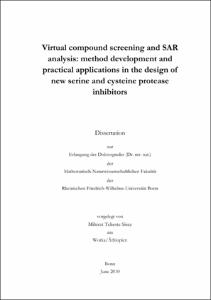Virtual compound screening and SAR analysis: method development and practical applications in the design of new serine and cysteine protease inhibitors

Virtual compound screening and SAR analysis: method development and practical applications in the design of new serine and cysteine protease inhibitors

| dc.contributor.advisor | Bajorath, Jürgen | |
| dc.contributor.author | Sisay, Mihiret Tekeste | |
| dc.date.accessioned | 2020-04-15T19:57:45Z | |
| dc.date.available | 2020-04-15T19:57:45Z | |
| dc.date.issued | 05.11.2010 | |
| dc.identifier.uri | https://hdl.handle.net/20.500.11811/4673 | |
| dc.description.abstract | Virtual screening is an important tool in drug discovery that uses different computational methods to screen chemical databases for the identification of possible drug candidates. Most virtual screening methodologies are knowledge driven where the availability of information on either the nature of the target binding pocket or the type of ligand that is expect to bind is essential. In this regard, the information contained in X-ray crystal structures of protein-ligand complexes provides a detailed insight into the interactions between the protein and the ligand and opens the opportunity for further understanding of drug action and structure activity relationships at molecular level. Protein-ligand interaction information can be utilized to introduce target-specific interaction-based constraints in the design of focused combinatorial libraries. It can also be directly transformed into structural interaction fingerprints and can be applied in virtual screening to analyze docking studies or filter compounds. However, the integration of protein-ligand interaction information into two-dimensional compound similarity searching is not fully explored. Therefore, novel methods are still required to efficiently utilize protein-ligand interaction information in two-dimensional ligand similarity searching. Furthermore, application of protein-ligand interaction information in the interpretation of SARs at the ligand level needs further exploration. Thus, utilization of three-dimensional protein ligand interaction information in virtual screening and SAR analysis was the major aim of this thesis. The thesis is presented in two major parts. In the first part, utilization of three-dimensional protein-ligand interaction information for the development of a new hybrid virtual screening method and analysis of the nature of SARs in analog series at molecular level is presented. The second part of the thesis is focused on the application of different virtual screening methods for the identification of new cysteine and membrane-bound serine proteases inhibitors. In addition, molecular modeling studies were also applied to analyze the binding mode of structurally complex cyclic peptide inhibitors. | en |
| dc.language.iso | eng | |
| dc.rights | In Copyright | |
| dc.rights.uri | http://rightsstatements.org/vocab/InC/1.0/ | |
| dc.subject.ddc | 004 Informatik | |
| dc.subject.ddc | 540 Chemie | |
| dc.subject.ddc | 610 Medizin, Gesundheit | |
| dc.title | Virtual compound screening and SAR analysis: method development and practical applications in the design of new serine and cysteine protease inhibitors | |
| dc.type | Dissertation oder Habilitation | |
| dc.publisher.name | Universitäts- und Landesbibliothek Bonn | |
| dc.publisher.location | Bonn | |
| dc.rights.accessRights | openAccess | |
| dc.identifier.urn | https://nbn-resolving.org/urn:nbn:de:hbz:5N-23233 | |
| ulbbn.pubtype | Erstveröffentlichung | |
| ulbbnediss.affiliation.name | Rheinische Friedrich-Wilhelms-Universität Bonn | |
| ulbbnediss.affiliation.location | Bonn | |
| ulbbnediss.thesis.level | Dissertation | |
| ulbbnediss.dissID | 2323 | |
| ulbbnediss.date.accepted | 01.10.2010 | |
| ulbbnediss.fakultaet | Mathematisch-Naturwissenschaftliche Fakultät | |
| dc.contributor.coReferee | Gütschow, Michael |
Dateien zu dieser Ressource
Das Dokument erscheint in:
-
E-Dissertationen (4306)




